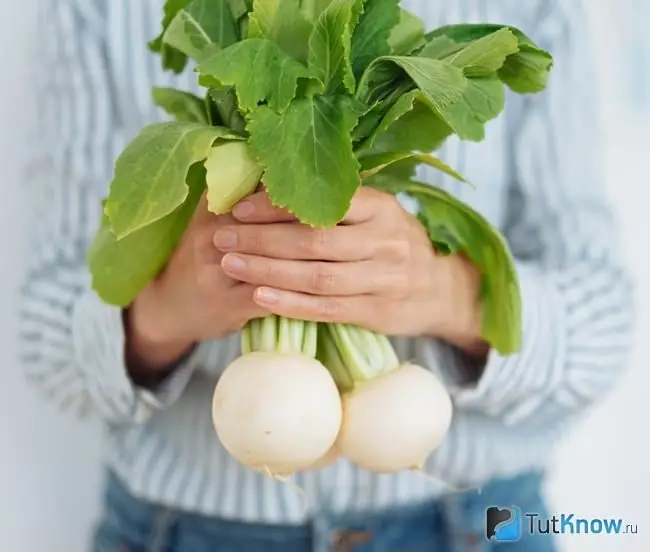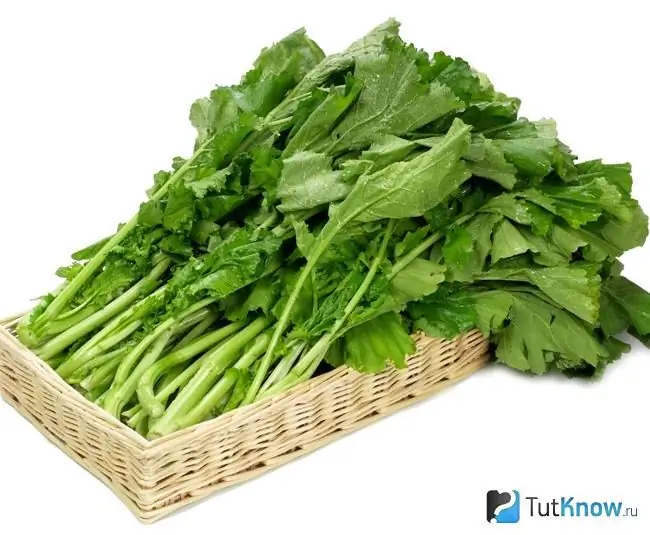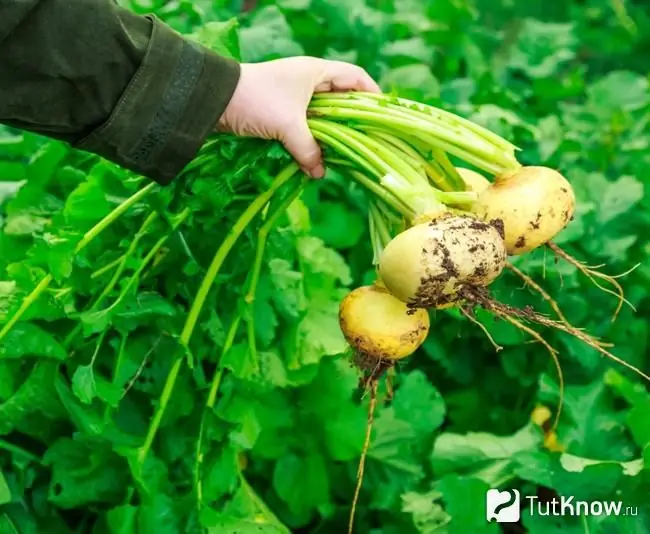Composition and calorie content of leafy turnip. The benefits and harms of kabu. Recipes for salads and hot dishes.
Leafy turnip is a salad crop popular in Asia. Alternative names are kabu, kokabu, kabuna. The plant is especially loved in Japan, it was here that they began to cultivate it for the first time. By the way, it is very young, the history of the kabu begins only in the 19th century, and they got it as a result of crossing the Far Eastern and European turnips. In a plant, it is not so much a root vegetable that is valuable as its leaves: the “roots” grow only up to 8-10 cm, but the “tops” can reach a height of 0.5 m! The culture is distinguished by early maturity - it ripens in 25-30 days, as well as unpretentiousness, it grows well both in greenhouses and in open ground in the spring and summer. However, it should be borne in mind that turnips grown on the street are coarser, and therefore they are usually used not fresh, but for salting or heat-treated dishes - soups, stews, marinades. Greenhouse turnips are sent to fresh salads.
Composition and calorie content of leafy turnip

In the photo leaf turnip
The culture is young and poorly researched. However, it is known for sure that the calorie content of leafy turnip, like any other salad culture, is very small. It can be used with a clear conscience even in the strictest dietary diet. The product is a source of protein and carbohydrates, contains absolutely no fat.
Cabuna is an excellent source of vitamin C, it is believed that there is as much of it in turnips as in bell pepper, which, by the way, holds the record for the content of this vitamin, more only in rose hips. Although, in fairness, it should be said that the concentration of ascorbic acid still depends on the variety - 40-95 mg per 100 g.
The product also contains beta-carotene, B vitamins and is rich in succinic acid, which, in principle, is rarely found in plant sources.
Various minerals are part of the turnip leaf (especially a lot of iron and calcium salts), as well as chlorophyll, fiber, phytoncides, anthocyanins, organic acids, mustard oil, sterols, essential oils.
Useful properties of leafy turnip

In Japan, cabuna is grown universally and is also commonly served on the table. It is considered a very useful product and is actively used in folk medicine for the treatment of colds of various kinds, relieving toothache, combating insomnia, vitamin deficiency.
The benefits of leafy turnip:
- Anti-inflammatory action … Phytoncides are unique plant components that are able to actively fight against any inflammation. However, in this case, not only this important element works, chlorophyll, mustard and essential oils also have an antimicrobial effect, and therefore the anti-inflammatory properties of the plant are very strong.
- Prevention of anemia … This is a disease characterized by a reduced number of red blood cells, which can be caused by many reasons. Lack of iron and other "materials" for the synthesis of hemoglobin, the most important of which is succinic acid, is one of the main reasons. Leafy lettuce turnips contain both iron and succinic acid, and therefore its regular use is an excellent prevention of anemia. In addition, here, again, mention should be made of chlorophyll, which is often referred to as the "blood of the plant", and speak of its excessive importance for the health of human blood.
- Antioxidant effect … In this case, vitamin C is especially valuable - one of the most powerful antioxidant vitamins. When a large number of free radicals are formed in the body, there is a danger of destruction of cellular structures and their mutation, which can cause various serious diseases, including cancer. Antioxidants neutralize free radicals and reduce the risk of developing corresponding diseases many times over.
- Strengthening immunity … Of course, one cannot fail to note the huge role of vitamin C for immunity. It strengthens the body's defenses, helps to actively resist various infections and viruses. The product protects especially well from colds, and therefore, during the period of epidemics, it simply needs to be introduced into the diet.
- Stimulating collagen synthesis … Finally, vitamin C is a responsible cofactor for the synthesis of collagen, a protein in the body that is required to build tissues of skin, nails, teeth, hair. However, collagen is not only youth and beauty, but also health, as this protein is also needed to build and support joints and bones.
- Beneficial effect on the nervous system … Due to the presence of B vitamins, as well as other plant components, it is believed that kabuna is capable of positively affecting the nervous system, it helps especially well against insomnia, and therefore it is advisable to include turnip salad in the evening meal.
- Normalization of the digestive system … The product contains a lot of fiber, which helps to normalize bowel function. Fiber affects peristalsis and sets its correct activity. Thus, with the inclusion of salad turnips in the diet, constipation, flatulence, and bloating can be avoided.
- Cleaning blood vessels and protecting the heart … The product is believed to have a cardiotonic effect as it can influence bad cholesterol levels as well as lower blood sugar levels. Both of these factors determine vascular health and, accordingly, high-quality prevention of acute cardiac conditions.
- Respiratory diseases treatment … The properties of turnips are absolutely unique in the treatment of respiratory diseases, and the plant is effective not only in the treatment of a banal cough, but also in various bronchitis, laryngitis, and loss of voice. Moreover, there is a positive effect of turnip in the complex treatment of asthma.
- Detox effect … Turnip helps with bowel function, which already creates a detox effect. But it also has a positive effect on the functioning of the kidneys, and this also plays a role in protecting the body from the accumulation of harmful substances, various toxins and toxins.
Leaf turnip has a beneficial effect on the entire body, making it comprehensively healthy, and therefore it is absolutely necessary for everyone to introduce it into the menu.
Contraindications and harm of leafy turnip

Unfortunately, the cabuna has some features that still somewhat limit its use for everyone. Like any other product with a "strong" composition, turnip leaves are very useful for a healthy body, but can lead to some unpleasant symptoms in the presence of diseases.
Turnip leaf can harm people with diseases of the digestive system - stomach, intestines, liver, kidneys. If you have corresponding diseases, be sure to first consult with your doctor about the advisability of introducing the product into the diet.
In addition, do not forget about individual intolerance. Leaf turnip, although it came from Asia, is not exotic for us, because the familiar European turnip took part in the creation of the hybrid. And, nevertheless, an individual allergic reaction is not excluded, so if you are trying a salad for the first time, you need to start with a small portion.
Finally, it should be said that it is always necessary to observe moderation, any product, even the most useful one, should be consumed in reasonable quantities. You do not need to eat cabbage three times a day and in huge portions, just add it to the salad once to get all the useful properties and not harm yourself at the same time.
Note! If you have diseases that are not related to the digestive system, but require a special diet, be sure to consult your doctor about the possibility of eating Japanese salad.
Turnip salad recipes

Of course, cabuna is an ingredient in a wide variety of summer fresh salads in the first place. Also, the leaves can always be added to vegetable stews, soup, or used as an ingredient in a marinade when salting vegetables.
Several recipes with leafy turnips:
- Bean sprouts salad … Cut cherry tomatoes (200 g) into halves, fresh asparagus (100 g) into 3-4 pieces, chop chili peppers (1 piece) into thin rings and green onions (20 g). Pick turnip leaves (150 g) by hand. Mix all ingredients, add legumes (50 g), root salad (50 g). Prepare a dressing: combine finely grated garlic (1 clove) and ginger root (10 g), olive oil (50 ml), sesame oil (1 tablespoon), chopped cilantro (10 g), lemon juice (from half fruit), pineapple juice (1 tablespoon). Whisk the dressing ingredients together, pour into the salad, stir and eat right away.
- Quick salad with beans and corn … Chop or pick leafy turnips (100 g) with your hands, chop the tomatoes (200 g) into cubes. Add prepared canned corn (300g) and beans (300g). Combine separately crushed garlic (2 cloves) with mayonnaise (50 g) and ketchup (50 g). Put the dressing in the salad, stir.
- Kabuna wok … Heat a wok, add sesame oil (2 tablespoons), soy sauce (1 tablespoon) and rice vinegar (1 tablespoon). After a minute, add green peas (100 g), fry for half a minute, put the turnips chopped in the form of "noodles", cook for another minute. Finally, add mint leaves (1 bunch), chili peppers (1), cut into rings, and turn off the heat. Let the dish "rest" for a couple of minutes and serve.
- Cabbage rolls in leafy turnips … Grate carrots (1 piece), finely chop the onion (1 piece), lightly fry the vegetables in olive oil. Divide the vegetables into two parts, leave one, and mix the other in a bowl with minced chicken (300 g), egg (1 piece), rice (100 g), your favorite spices and salt to taste. Take lettuce leaves (you will need about one small "fork") and put the filling on them, if you have them tough, you can pre-pour boiling water over them. Place the formed cabbage rolls in a pan, fry on both sides. Meanwhile, mix the remaining vegetables with tomato paste (2 tablespoons), salt and pepper to taste. Put the cabbage rolls on the sauce, pour in a little boiling water and simmer the dish for 30-40 minutes. Serve with the sauce and sour cream.
- Spicy Asian Soup … Heat the wok, pour in the olive oil (50 ml), add the chopped chicken thigh fillet (100 g), lightly fry, add the chopped turnip leaves (1 small fork), cook another 3-5 minutes. Add chili paste (1 tablespoon), soy sauce (2 tablespoons) and fish sauce (1 tablespoon), and sugar (1 tablespoon), simmer for 20 minutes. Pour in water (the amount is determined by taste preferences in terms of thickness and pungency), add diced tofu (300 g), rice noodles (100 g), cook until the noodles are done. Serve with green onions.
Thus, both specific Asian dishes and Russian familiar to us can be cooked with kabuna, so be sure to experiment and do not be afraid to use this ingredient.
Interesting facts about leafy turnip

Many traditional Japanese dishes are prepared with turnip salad, and chefs use not only the leaves, but also the seedlings and roots of the plant.
It is noteworthy that they tried to cultivate cultures similar to kabuna already 2 thousand years ago. As a rule, they were grown on heavy clay soils, where it was impossible to cultivate another popular Asian culture - the daikon. At that time, kabuna was only a substitute for a more delicious fruit and was not overly appreciated. But when the first successful hybrid appeared in the 19th century, various varieties with excellent taste were bred, lettuce turnip became almost more popular in Japan than daikon.
Unfortunately, cabuna has not yet taken root in Russia, and it is a pity, because it is an excellent alternative to the classic turnip, since it is no less useful, but has a much more pleasant taste, due to the fact that it contains less mustard oils and more sugars.
Cabuna is one of the earliest ripening crops, especially "fast" varieties ripen in 3 weeks, most of all existing ones are ready in 4-5 weeks, but there are also those that need to wait 8-9 weeks. Generally, the larger the leaves and the smaller the fruit, the faster the crop grows, and vice versa. The earliest ripening varieties are sapphire, Tokyo, turquoise; the longest ripening are Snow Maiden, Snow White, White Night.
Growing a leafy turnip is a simple matter, it is unpretentious, it tolerates heat and cold well. In the ground, the plant can even survive frosts down to -3OC. It is also undemanding to sunlight, and therefore in winter the culture grows well on the windowsill.
Watch a video about leafy turnip:

Leafy turnip is a valuable crop. It has good taste and rich chemical composition. Kabuna can easily diversify your menu, it can be added to any fresh salad and make it even healthier. It will also be good in hot dishes. Be sure to try the salad turnip, if you are not yet familiar with it, then first read the contraindications.






